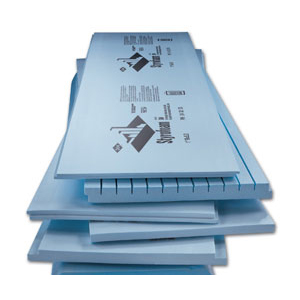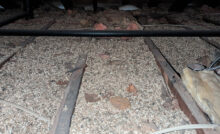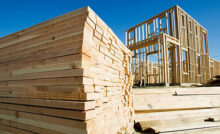Basement Insulation
Basement Insulation – Walls
Basement insulation is far more complicated than insulating regular wood framed walls. In fact, improperly insulated basement walls are one of the biggest reasons for mold in homes. If you don’t do this correctly you’ll be exposing your family to dangerous mold exposure. In this article I’ll show you How To Insulate Basement Walls properly.
It’s All About Water Vapor


In addition, and likely more serious, is water vapor escaping from the concrete wall and trying to escape to inside the finished room. Concrete looks just like a sponge under a microscope and it holds water just like a sponge. In fact, over the entire life of concrete it holds water. So concrete is ALWAYS letting off water vapor and that water vapor is trying to either dry to the outside or into your finished space. To fully understand this please read our basement insulation vapor barrier article.
What NOT To Do When Insulating A Basement
Under no circumstances should you try either of these methods for insulating basement walls. Both of these are similar, both of these are methods I see all the time, and they ALL end up with mold problems:
- Layer of plastic poly installed over the concrete wall. Next a wall is framed and fiberglass insulation is installed in the stud bays. In some cases this is either kraft faced or another layer of poly is installed. This situation is bad because any water vapor that gets into the stud bays will end up condensing on the surface of the poly (the poly will be as cold as the concrete wall, around 50 degrees F.), the water then causes mold to start growing in the nicely tented space between studs.
- A stud wall is built such that it’s an inch or two away from the concrete. In this case only fiberglass insulation is installed between studs (no plastic on concrete). A vapor barrier is installed, then drywall. This situation is really bad, water vapor from the concrete escapes into the stud cavity and condenses on the back of the vapor barrier behind the drywall. Again, water creates a nasty mold situation in the stud bay.
These are horrible details, no amount of water proofing, concrete sealer, etc is going to make them better. My advice is simple: DO NOT EVER USE those details.

Closed Cell Foam Is The Answer
Whether you spray it in place or install sheets, closed cell foam is the answer for basement insulation. When properly installed, closed cell foam (spray or board) provides two benefits: first and foremost it’s a great insulator with MUCH better R values per inch than fiberglass, and secondly when you use closed cell foam that’s at least 1-1/2 inches thick, it actually acts as a vapor barrier. So essentially you get a vapor barrier and insulation all wrapped into one easy to use product.
DIY Basement Insulation Using Foam Board
The following is a great example of proper DIY basement insulation. If you’d like to see a more detailed article on how to do use this approach you can see that HERE.
Several years ago I insulated the basement walls in our basement storage room. I installed 1-1/2″ extruded polystyrene foam insulation board by DOW. I used a special Styrofoam adhesive to adhere the foam board to the concrete (you can also use “Great Stuff Pro” foam in a can). The foam board I am used comes with a tongue and grove so installation is pretty easy. Just cut the boards to length, apply some adhesive and press it against the wall. Note, you may need to apply pressure to the foam with boards until the adhesive dries.
If you’d like to see a video of this type of approach check out our DIY Basement Insulation Video.
You’ll notice that I installed the boards horizontally. Since doing this project we’ve been installing them vertically at work and it’s much easier to do! Placing them vertically makes it much easier to keep them from falling down while the adhesive cures.
Seal Insulation Joints
Updated (Oct 2014)
Years ago when I first started using this method there were very few options available for tape products to seal foam board insulation panels. Back then I used Tyvek tape but that product is no longer recommended for use on foam board. Most of the foam board manufacturers now manufacture tapes made specifically for sealing these products. DOW offers the WEATHERMATE™ Construction Tape, and Owens Corning has JointSealR™ Foam Joint Tape. These products are more expensive, but they are specifically designed for this application and very important to the long term performance of the insulation barrier.
Frame Basement Walls
Once all the insulation was in place I started framing up 2×4 walls. I placed the walls directly in front of the foam insulation and then insulated the wall cavities with fiberglass insulation. You’ll need to nail the pressure treated plate of the wall to the concrete with a Trigger Tool Kit, 22 Caliber.
You may be wondering why I used fiberglass insulation after giving it a black eye above. We can use it in this situation because we have an insulated vapor barrier between it and the concrete. By doing the combination of insulation materials I achieved approximately an R values of 16. This was much cheaper than doing it all in foam.
There is also some really great information at the Building Science Corporation.
Insulated Concrete Floors
For this project we didn’t insulate the concrete floors because we have radiant heated slabs. However, if your home doesn’t have radiant heat and you’re looking for information on that topic then we recommend you read How To Insulate A Concrete Floor.
Recent Posts
Framing Stick Nailer vs Coil Nailer
Which is Better a Stick Nailer or Coil Nailer? Framers have many choices in nailers…
How Many Roofing Nails Per Square of Shingles
Estimating How Many Nails for a New Roof When it comes to estimating materials for…
Composite / PVC Decking – Layout Tips & Advice
Composite / PVC Decking Layout Tips and Advice Composite and PVC decking have really changed…
Benefits of an ERV System (Energy Recovery Ventilator)
Benefits of ERV Systems (Energy Recovery Ventilator) If you're building a new home or doing…
Vermiculite Attic Insulation Abatement
Vermiculite Attic Insulation If your home was built before 1990 there is a chance it…
Nuisance Tripping of AFCI (Arc Fault) Circuit Breakers
Arc Fault (AFCI) Circuit Breakers Tripping Often An arc-fault circuit interrupter (AFCI) or arc-fault detection…



View Comments
My question is : do you still need foam insulation to grade on the exterior of the basement walls if you insulate as directed on the inside? Thanks so much for your helpful information.
Not necessarily. Many people do. One reason to consider it, because it helps keep water away from the foundation wall. It's a good first line of defense.
Great advice. I was wondering what to put directly on the concrete walls if drain tile was installed in the interior and dimpleboard was was run about one foot up the basement wall. This would would obviously cause the foam board to be away from the wall or do I just rest it on the dimpleboard? Also, what stops the vapor from traveling up the wall and entering the ceiling joists. Thank you
Ron - You can place the foam directly over the dimple board. The idea is to seal the top with tape and/or spray foam.
When doing the framing for the walls, do I want to insulate the floor first. That way I can get foam board down before I put the 2x4 baseboard down, or do I want that 2x4 to be on the concrete floor.
David
Dave - Either approach will work. Good luck.
If the basement has already been framed, how can we seal the foam boards behind the 2x4 to create the barrier needed.
My recommendation is to move those walls (not as hard as you think) away from the wall so you can insulate correctly.
How do you keep a continuous foam insulation/vapor barrier when you have drains and stacks right against or maybe an inch from the concrete walls? Is it okay to use 2" foam everywhere and just slip a 1" piece the width of the pipe tightly behind the pipe and tape it to the 2" on either side? Or should I just insulate around it and frame around it?
James - You do the best you can! :) Obviously in a remodeling situation it's nearly impossible to get it perfect. Your solution is spot on. Good luck.
Todd,
The bottom half of my foundation wall is 12" poured cocrete and continues with an 8" CMU the rest of the way up, creating a 4"- 5" ledge on the interior face. I would think using the foam board method would not work as well in this condition. Any ideas.
It will work fine, you just need to step the insulation and seal the joint well. Good luck.
Todd- Great blog! Can I install my 2" of XPS foam over a painted concrete wall? I am having great difficulty removing the paint (have gotten it down to 1 to 2 layers and bare in some spots) and contractors I've called are not interested in helping complete the paint removal task. I am concerned the paint could become a food source for mold behind the XPS foam. Is that a concern or does it not matter if its behind the vapor barrier? Should I add a skim coat of concrete to the existing wall to cover up the paint so it isn't directly touching the foam? Thanks!!
I wouldn't worry about the paint, just be sure to remove any loose paint and clean the the surface real well. Good luck.
Hello Todd - I'm finishing my basement and the baseement was comleted with the big silver padding insulation that is nailed to the concrete. What is your recommendation on how to finish the basement walls with this type of insulation already there?
I'm assuming you mean that your basement has some sort of "bagged" fiberglass insulation? If it were my home I'd remove that insulation and use closed cell foam board. In my professional opinion fiberglass insulation has NO place in insulating basement walls.
Good luck.
Hi Todd,
Thank you very much for your write up. In the mechanical room of my basement I currently have a foil backed fiberglass nailed to poured concrete wall (it is not 'bagged' so fiberglass is directly against concrete I guess it is something similar to http://www.specjm.com/products/faced/fsk25.asp). I was planning on installing the foam boards as you suggest. My question is, can the foam boards just be left exposed? I have no need/desire to frame in walls in this part of the basement (rest of the basement is finished). I basically just want to get rid of the exposed fiberglass insulation.
Jeff - Technically you should not as it poses a fire hazard. Most building codes specify a minimum flame spread rating for occupied spaces. Check with your local building code official on the requirement, then check the product information on the foam you're considering. Most do not meet the standard and therefore need some protection.
Hi Todd, Love the articles here. I have a 50's house with a "finished" basement. The foundation walls have plastered applied directly onto the concrete. I want to frame some of the exterior walls so that I can extend the electrical and drywall nicely around my new windows. Can I apply the closed cell foam directly to the plaster? Many thanks!
Peggy - In some situations plaster can promote mold growth. So there is a slight risk that mold could develop behind the foam if the conditions will support mold growth. Having said that, I think it's certainly a possible solution. You might want to consider some type of paint that helps prevent mold to at least seal the plaster first. Good luck.
That is terrific advice, I'll do that. Living in Colorado I don't worry about mold too much but it is possible. Thanks again!